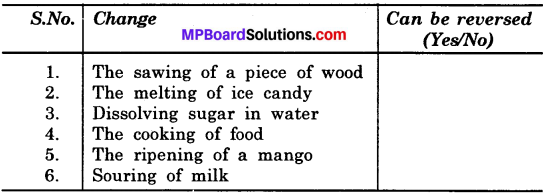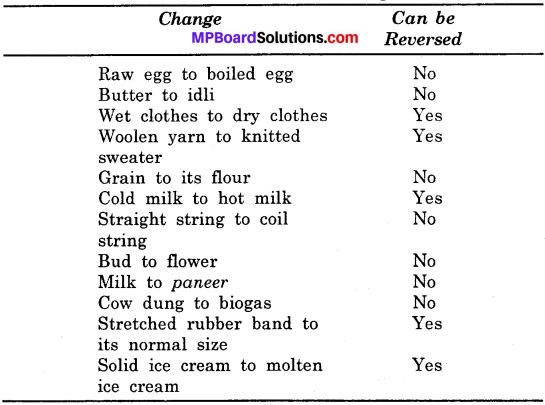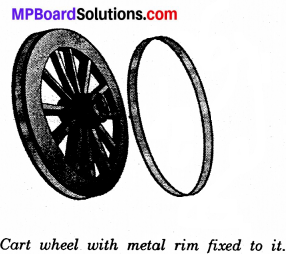MP Board Class 6th Science Solutions Chapter 6 Changes Around Us
Changes Around Us Textbook Exercises
Question 1.
To walk through a waterlogged area, you usually shorten the length of your dress by folding it. Can this change be reversed?
Answer:
Yes, this change can be reversed.
Question 2.
You accidentally dropped your favourite toy and broke it This is a change you did not want Can this change be reversed?
Answer:
No, this charge can not be reversed.
Question 3.
Some changes are listed in the following table. For each change, write in the blank column, whether the change can be reversed or not?

Answer:
- No
- Yes
- Yes
- No
- No
- No.
Question 4.
A drawing sheet changes when you draw a picture on it. Can you reverse this change?
Answer:
If the picture is drawn with a pencil, then it can be erased, hence the change can be reversed. But if the picture is drawn with colours, the change cannot be reversed.
Question 5.
Give examples to explain the difference between changes that can or cannot be reversed?
Answer:
A change is said to be reversible or reversed when it can occur in both the forward and backward directions. For example, melting of ice in water and then its condensation into ice again; filling water with jug; opening or closing the door, etc. A change is said to be irreversible or cannot be reversed when it occurs only in one direction. For example, burning of match – stick repening of fruit; curdling of milk, etc.
![]()
Question 6.
A thick coating of a paste of Plaster of Paris (POP) is applied over the bandage on a fractured bone. It becomes hard on drying to keep the fractured bone immobilised. Can the change in POP be reversed?
Answer:
No, the change in POP cannot be reversed.
Question 7.
A bag of cement lying in the open gets wet due to rain during the night. The next day the sun shines brightly. Do you think the changes, which have occurred in the cement, could be reversed?
Answer:
No, the changes which have occurred in the cement cannot be reversed.
Projects and Activities
Activity 1.
Make a table to show some common changes?
Answer:
Some common changes

Question 2.
Paheli wants to know if you have ever seen a blacksmith making some tools. How does a blacksmith change a piece of iron into different tools? A piece of iron is heated till it becomes red – hot. It then becomes soft and is beaten into a desired shape. What change has taken place in iron, on being heated?
Answer:
Expansion.
Changes Around Us Additional Important Questions
Changes Around Us Objective Type Questions
Question 1.
Choose the correct answer:
Question (a)
Which of the following is not reversible change?
(а) Burning of a piece of paper
(b) Ploughing a field
(c) Pulling of rubber string
(d) Melting of wax.
Answer:
(а) Burning of a piece of paper
Question (b)
From the following which is an irreversible change?
(а) Leaves turn yellow:
(b) Falling of leaves from tree
(c) Leaves turn into manure
(d) All the above.
Answer:
(d) All the above.
![]()
Question (c)
Chemical changes are:
(a) Always reversible
(b) Sometimes reversible
(c) Irreversible
(d) None of these.
Answer:
(a) Always reversible
Question (d)
All chemical changes are necessarily:
(a) Irreversible
(b) Reversible
(c) Fast
(d) None of these.
Answer:
(v) None of these.
Question 2.
Fill in the blanks:
- Changes that repeat after a certain interval of time are called ……………………..
- Changes that lead to the formation of new substances are called ……………………………
- Burning of wood in a chulha is a …………………….. change but forest fire is an
- Melting of candle wax is a …………………….. change but its burning is a …………………….. change.
- Energy is ……………………… in the formation of curd from milk.
Answer:
- Periodic changes
- Chemical changes
- Desirable change, undesirable change
- Physical, chemical
- Liberated.
![]()
Question 3.
Which of the following statements are true (T) or false (F):
- Cooking of rice is a physical change.
- Breaking of a china dish is a chemical change.
- Rusting of iron is an irreversible change.
- Eruption of a volcano is a periodic change.
- Formation of clouds is a fast change.
Answer:
- False
- False
- True
- False
- False.
Question 4.
Match the items in Column A with items in Column B:

Answer:

Changes Around Us Very Short Answer Type Questions
Question 1.
Is picking of mango a desirable change? Why?
Answer:
Picking of mango is always a desirable change. We pickle mango according to our taste and desire.
Question 2.
Is printing a reversible or an irreversible change?
Answer:
Printing is irreversible change because printed matter cannot be easily erased.
Question 3.
Can you obtain wood from sawdust?
Answer:
We cannot obtain wood from sawdust because it is an irreversible change.
Question 4.
Why we classify the changes taking place around us?
Answer:
We classify the changes taking place around us to have better understanding of these changes. We classify changes according to the nature of the change.
![]()
Question 5.
What is a slow change? Give examples?
Answer:
A change which occurs slowly and completes in days, months or years is a slow change. For example, rusting of iron, change of seasons, ageing, growth of a tree, weathering of rocks, etc.
Question 6.
What is a fast change? Give examples?
Answer:
A change which occurs rapidly and completes in seconds or a minutes is a fast change. For example, breaking of glass tumbler, burning of a match – stick, beating of heart, explosion of a pracker, etc.
Question 7.
What change takes place when an iron rod is heated up and cooled down?
Answer:
It is an irreversible change.
Question 8.
Can we say that ironing of clothes is a reversible change? Answer with reason?
Answer:
Yes, in the sense that ironing of cloth does not make a permanent change in the cloth fibre yet we can say it may be called as an irreversible change because ironing affects the upper surface of cloth which is consumed.
Changes Around Us Short Answer Type Questions
Question 1.
What is a physical change? Give examples?
Answer:
A change is said to be a physical change when it involves the change only in the physical properties of a substance. The chemical properties are retained. For example, melting of ice, heating of water, moulding of clay, magnetization of iron piece, etc.
Question 2.
What is a chemical change? Give examples?
Answer:
A change is said to be a chemical change when it involves the change both in the physical and chemical properties of a substance. For example, curding of milk, burning of magnesium ribbon to form magnesium oxide, rusting of iron, to form oxide, burning of fuels to form ash and carbon dioxide, etc.
Question 3.
Formation of clouds is a physical change; Explain?
Answer:
The formation of clouds is a physical change because water from rivers, lakes or oceans evaporates, then it is converted into water vapours it is a temporary change. The change is reversible. There is no change in composition.
![]()
Question 4.
Explosion of a cracker is a chemical change. Explain?
Answer:
In the explosion of a cracker the mixture of sulphur, nitrate and other substances burn. There is an evolution of energy. The change is not reversible and the smoke and other gases cannot be converted back into the cracker.
Question 5.
Give two examples of changes in which energy is given out?
Answer:
The two examples of changes in which energy is given out are:
- Burning of magnesium ribbon to form magnesium oxide.
- Addition of sulphuric acid in water produce heat.
Question 6.
Give two examples of changes in which energy is absorbed?
Answer:
The two examples of changes in which energy is absorbed are:
- Evaporation of alcohol.
- Dissolution of ammonium chloride in water.
Question 7.
What are natural and man – made changes? Give examples?
Answer:
The changes which occurs in nature are called natural changes. For example, change of seasons, growth of child, germination of seed, weathering of rocks, flowering of plants, etc. The changes which do not occur in nature but are carried out including by man are called man – made changes. For example, burning of fuel, melting of wax, breaking of stones, making of ice – cream, etc.
Question 8.
Is burning always a desirable change? Explain?
Answer:
Burning of wood or coal in our homes is a desirable change as it is useful to us. Burning of wood or charcoal will become an undesirable change if burning of wood produces smoke and pollutes the air. Similarly burning of wood unnecessarily should be avoided as it is wastage of costly wood. Burning of petrol, kerosene oil is a source of pollution of air in cities.
![]()
Question 9.
Is falling of trees always an undesirable change? Give reasons?
Answer:
Falling of trees for making furniture or timber is a desirable change. Though falling of trees can be undesirable because forest wealth will be lost when falling of trees is taken on a large scale.
Question 10.
Sort out reversible changes from the following:
- Melting of ice
- Wheat turn into flour
- Melting of wax
- Making of ice – cream from milk
- Growing old.
Answer:
Reversible changes are:
- Melting of ice
- Melting of wax.
Question 11.
Classify the following as physical or chemical changes:
- Melting of glass
- Burning of agarbatti
- Tearing of cloth
- Formation of seed from flower
- Cooking of food
- Formation of cloud.
Answer:
Physical change:
- Melting of glass.
- Tearing of cloth.
- Cooking of food.
Chemical change:
- Burning of agarbatti
- Formation of seed from flower.
- Formation of cloud.
Question 12.
Classify the following as reversible or irreversible changes:
- Growth of a plant
- Ploughing a field
- Melting of wax
- Falling of rain
- Pulling of rubber string
- Breaking of a glass rod
- Cooking of food.
Answer:
Reversible change:
- Ploughing a field
- Melting of wax
- Pulling of rubber string
Irreversible change:
- Growth of a plant
- Falling of rain
- Breaking of glass rod
- Cooking of food.
![]()
Question 13.
See the picture and tell, in the candle:
- Which type of change is melting wax? Explain?
- Which type of change is burning wax? Explain?
Answer:
- The melting of wax is a physical change, because during this process of melting, it is changing into liquid state and after cooling down, again it becomes solid.
- The burning of wax is a chemical change because when the cotton wick embeded in the candle is burnt, ash and smoke is formed. It is not possible to make a wick from this ash and smoke.

Question 14.
Most physical changes are reversible, give reasons?
Answer:
In physical changes there is no change in the composition of substances. There may be a change in size, shape of the substances where a physical change takes place. Hence it is possible to produce the reactants from the products easily. The physical changes are mostly reversible.
Changes Around Us Long Answer Type Questions
Question 1.
How metal rim is fixed on the wooden wheel of a cart?
Answer:
The metal rim is made slightly smaller than the wooden wheel. On heating, the rim expands and fits onto the wheel. Cold water is then pouted over the rim, which contracts and fits tightly onto the wheel.

Question 2.
How wooden handle is fixed in the ring of the iron tool?
Answer:
The iron blade of these tools has a ring in which the wooden handle is fixed. Normally, the ring is slightly. smaller in sir e than the wooden handles fix the handle the ring is heated and it becomes slightly larger in size (expands) Now, the handle easily fits into the ring. When the ring cools down it contracts and fits tightly on to the handle.

Question 3.
Give reason of:
- Rotation of fan is a periodic change.
- Rusting of iron is a chemical change.
- Ripening of fruit is an irreversible change.
Answer:
1. Rotation of fan involves the movement of the blade, takes place at a fixed speed This movement is repeated after definite interval, hence the rotation of fan is a periodic change.
2. Rusting of iron is a chemical change because when the iron comes in contact with moist air, then it reacts with oxygen present in the air and starts rusting. Rusting of iron cannot be changed back into pure iron.
3. Ripening of fruit produces a change in the composition of the fruit. Ripened fruit cannot be changed back into the unripened fruit. It is an irreversible change. Hence this change is a chemical change.
Question 4.
What are desirable and undesirable changes? Give example?
Answer:
The changes which are useful to us are desirable changes. The changes which are not useful to us are called undesirable changes. We like the desirable changes to happen again but not the undesirable changes. The desirable changes include growth of a tree, undesirable changes. The desirable changes include growth of a tree, flowering of a plant, germination of seeds, formation of manure from cow – dung etc. The undesirable changes include breaking of glass tumbler, rusting of iron, rottening of food – stuffs, etc.
Question 5.
Give two examples of changes which are both desirable and undesirable?
Answer:
1. The burning of fuels like wood, coal or petrol is both desirable and undesirable change. The burning of fuels produce heat which is desirable but the burning also produce smoke. It pollutes the atmosphere and is undesirable.
2. The cutting of tree for wood is both desirable and undesirable change. The cutting provides wood for making furniture is desirable. At the same time the cutting of tree is undesirable because it destroys the natural balance.
![]()
Question 6.
Mention any three undesirable changes from your daily life?
Answer:
The three undesirable changes are:
- The burning of wood because on burning wood produces ash and smoke. Ash pollutes water and land, and smoke pollutes air.
- Rottening of food – stuff by bacteria or fungi. It spoils the food and makes it undesirable for eating purposes.
- Rusting of iron because iron after rusting corrodes and cannot be welded.
Question 7.
Differential between physical and chemical change?
Physical change:
- It involves change in the physical properties.
- It is temporary.
- It does not involve formation of new substance.
- It does not involve any energy change is substance.
Chemical change:
- It involves change both in the physical and chemical properties.
- It is permanent.
- It involves the formation of new substance.
- It involves energy changes as the chemical reactions are either exothermic or endothermic.
Question 8.
Classify the following changes in as many ways as you can:
- Breaking of a brick with hammer.
- Beating of heart.
- Germination of seed.
- Burning of an incense stick (agarbatti).
- Occurrence of solar eclipse.
Answer:
- Breaking of a brick with hammer is a fast, irreversible, undesirable, unperiodic and a physical change.
- Beating of heart is slow, periodic, irreversible and a desirable change.
- Germination of seed is slow, irreversible, unperiodic, desirable and a chemical change.
- Burning of an incense stick (agarbatti) is a slow, irreversible, desirable, periodic and a chemical change.
- Occurrence of solar eclipse is a non – periodic, an irreversible and a physical change.
![]()
Question 9.
State the criterion/reason for each of the following:
- Cooked food is stored in a refrigerator,
- Iron sheet is coated with tin before making a can,
- Common salt is stored in ari airtight container during the rainy season?
Answer:
1. Cooked food is stored in a refrigerator to prevent it from rotting. In the refrigerator the temperature of the food is lowered and degeneration of food material does not take place. It remains worth eating for many days. It gets preserved.
2. Iron sheet is coated with tin before making a can because coating with tin projects iron from rusting. This protects the can and it can be used for a longer time than the can which is not coated with any protecting metal.
3. Common salt is a substance which absorb water from the atmosphere. It gets wet and corrodes the container made of iron or aluminium. To prevent the absorption of water by the common salt we have to store it in an air it tight container during rainy season.
Question 10.
Choose appropriate alternative and give reason for your choice in the following statements?
- Occurrence of an eclipse of moon is a periodic/non – periodic change.
- Catching cold is a periodic change/non-periodic change.
- Arrival of a comet is a periodic/non-periodic change.
Answer:
- Occurrence of eclipse of moon takes place when moving earth comes in between the sun and the moon is a non – periodic change because eclipses of the moon do not occur after specific intervals.
- Catching cold is not a periodic change because it is not at all necessary that common cold may inflict a person at specific intervals of time.
- Arrival of comet is also a non – periodic change because comets do not arise after specific time. They form occasionally and may not occur for many years.